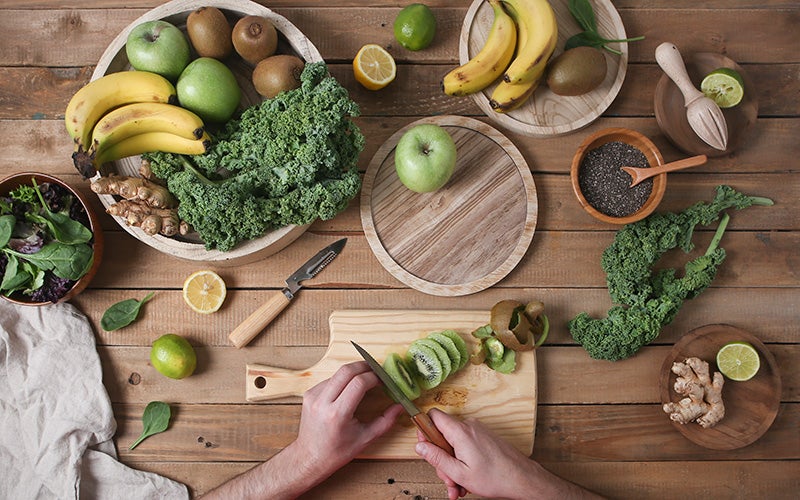Weight Loss Nutrition Plan: Eat the right way to lose weight!
 ©westend61
©westend61
A good weight loss nutrition plan can help you lose weight without starving yourself or depriving your body.
We’ll show you what makes a good weight loss nutrition plan and what you need to bear in mind.
Calculate Your Total Energy Expenditure
No matter what you eat and how much exercise you do, the key to long-term body fat reduction is your calorie balance.
You only lose weight when the calories you burn exceed the calories you consume.
A negative calorie balance causes the body to burn fat. Fat burning is an almost constant process and depends on your energy requirements and the intensity of your physical activity.
Support your metabolism with the right weight loss nutrition plan.
Reduce Your Total Calorie Intake to Lose Weight
The total energy expenditure (calculated amount of calories for your goal) is the basis of your weight loss nutrition plan. This amount depends on your size, weight, age and your daily activity.
Caution: Does a large calorie deficit equal significant weight loss? It’s very tempting to think that increasing your calorie deficit will accelerate your weight loss.
This approach, however, won’t work long-term. It often leads to just water and muscle being broken down, rather than the stubborn fat reserves.
The result of consuming too few calories: The metabolism slows down and the body struggles to process what little energy you put in.
You would have to eat less and less to counteract the process and to continue losing weight.
If you then eat a little more, the body comes out of energy saving mode and starts storing the energy as body fat for the next “lean times”. The result is the dreaded yo-yo effect.
The reason: Eating below your basal metabolic rate long-term will slow down your metabolism.
It is important that your calorie deficit is no more than 300 to 500 kcal below your total energy expenditure.
If you’ve used our calorie calculator, you have nothing to deduct. 500 kcal is automatically deducted when you choose weight loss as your goal.
With a calorie deficit of 500 calories a day, you can reduce body fat by up to 0.5 kg a week.
0.5 to 0.8 kilograms per week is regarded as healthy and steady weight loss.
Weight Loss Nutrition Plan: The Nutrient Ratio
Make sure that you consume vital macronutrients like high-quality proteins, fiber-rich carbohydrates and healthy fats at regular intervals.
Protein: 1.8 to 2.3g of protein per kilogram of body weight
Only a calorie deficit will allow you to reduce body fat.
At the same time, the body must receive a sufficient supply of protein. A sufficient protein intake maintains your muscle mass and protects it from being broken down.
Eat low-fat, protein-rich foods like chicken, beef, fish, eggs and dairy products.
Carbohydrates: 1-2g per kilogram of body weight
Carbohydrates are the fuel in a weight loss nutrition plan.
Only with a moderate and sufficient carbohydrate intake can you stabilize your performance level and increase the intensity.
Go for long-chain carbohydrates like wholegrain products, oats and rice.
Fat: Approx. 1 gram of fat per kilogram of body weight
Good weight loss nutrition plans account for the fact that a supply of healthy fats is also important.
Give preference to unsaturated fatty acids from plant oils (coconut oil, olive oil, hemp oil, flax oil), fish (cod, salmon), avocado and walnuts.
Example Day for a Weight Loss Nutrition Plan
What could your weight loss nutrition plan look like?
Using an example day, we want to show you how to reach the required daily calorie amount for weight loss while keeping an eye on your macro nutrient ratio (proteins, carbohydrates and fats).
Nutrient Ratio – Sample Calculation
A 25-year-old man, 1.80 m tall, weighing 80 kg. He has been doing weight training 2-3 times a week for 2 months.
His daily requirement for his weight loss nutrition plan is 1800 calories with the following distribution of nutrients:
- 540 calories from carbohydrates (30% of the daily total) = 130 grams
- 630 calories from protein (35% of the daily total) = 150 grams
- 630 calories from protein (35% of the daily total) = 70 grams
Breakfast
(434 calories: 17.5 g fat, 31.3 g carbohydrates, 34.4 g protein)
Shake consisting of:
- 300 ml water
- 1 apple
- 150 g mixed berries
- 30 g Organic Peanut Butter
- 30 g Whey Protein
Lunch
(377 calories: 3.1 g fat, 39.8 g carbohydrates, 45.7 g protein)
- 200 g wild salmon
- 250 g potatoes
- 200 g asparagus
Dinner
(459 calories: 13.1 g fat, 3.8 g carbohydrates, 78.8 g protein)
- 250 g turkey strips
- 125 g mozzarella
- Mixed peppers
Snacks
(500-600 calories)
- Rice cakes with a little honey
- Fruit and/or vegetable salad
- Trail mix/almonds/cashews
- Protein bar
- Protein shakes
Weight Loss Tips
If you lead a stressful life and have very little spare time, covering the increased protein requirement through conventional food can be difficult.
In addition to your weight loss diet, we recommend sports nutrition to cover the increased demand for proteins and amino acids.
L-Carnitine – The Amino Acid for Improved Efficiency
Carnitine is made up of the two amino acids methionine and lysine and has a positive influence on the energy gained from fatty acids.
High-quality foodspring® L-Carnitine contains Carnipure, the high-quality raw material from Switzerland.
Our L-carnitine is free of all harmful substances – guaranteed. And the capsules are made of plant-based cellulose fibers rather than animal gelatine, making them 100% vegan.
- Supports your workouts
- Premium Swiss quality Carnipure®
- Vegan capsule shells – no animal gelatin
Download our nutrition plan PDF template now!
Download Our Free Nutrition Plan as a PDF
Our Tip: Looking for maximum weight loss success? Get started on the right foot with our free Body Check. Calculate your BMI, define your goals, and get nutrition and workout ideas that get you there!
Start Your Free Body Check Now
Sources for this article
We at foodspring use only high-quality sources, including peer-reviewed studies, to support the facts within our articles. Read our editorial policy to learn more about how we fact-check and keep our content accurate, reliable, and trustworthy.





























